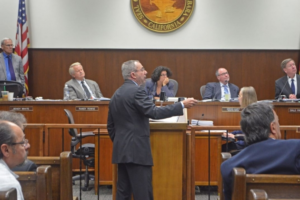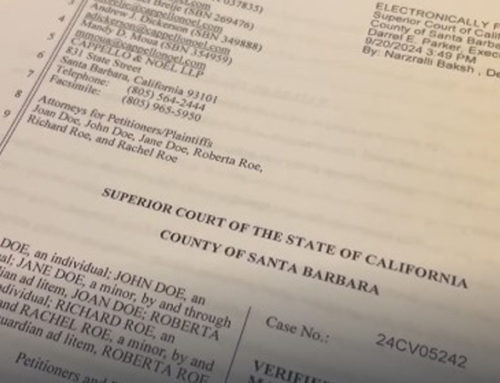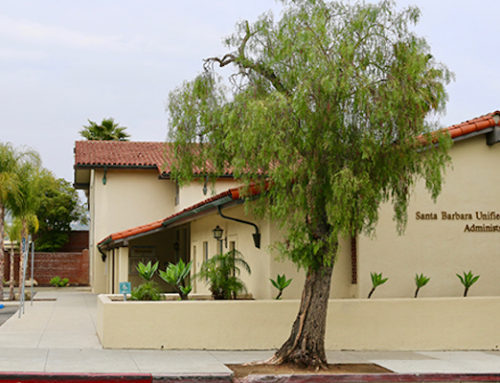By Giana Magnoli, Noozhawk News Editor | @magnoli | Published on 03.29.2015
After lengthy deliberations over how to divide city, council to pick final map Monday as required by settlement of California Voting Rights Act lawsuit

Barry Cappello, lawyer for the plaintiffs in a California Voting Rights Act lawsuit against the City of Santa Barbara, leads City Council members through prospective district boundary scenarios under consideration after the city settled the suit. (Giana Magnoli / Noozhawk file photo)
Santa Barbara voters will elect council members by district instead of at large starting in November, as a result of the city’s agreement to settle a California Voting Rights Act lawsuit.
The City Council will choose the six-district map at Monday’s special meeting, which begins at 4 p.m. in the council chambers at City Hall, 735 Anacapa St.
Council members narrowed the potential maps to three options at the last meeting. Click here to view the three choices.
The lawsuit alleged that the city has racially polarized voting, and that Latino votes are diluted in the at-large election system. The suit was filed by trial lawyer Barry Cappello on behalf of several Latino registered voters.
The city did not admit a violation of the state Voting Rights Act or any other law with the settlement agreement, which, according to the agreement, the city entered “to avoid the cost and expense of litigation.”
Here are the things to know about the new system and the impacts on the city’s election process:
-
- Santa Barbara voters will select one council member every four years, instead of three council members every two years. Under the previous at-large system, each voter got to vote for all six City Council seats and the mayor, but will only vote for one council member and the mayor starting with the November election.
-
- The district boundary maps are chosen by the City Council, challenged or accepted by the lawsuit’s plaintiffs, and then will go to a Santa Barbara County Superior Court judge for a final judgment in the case.
-
- Settlement discussions for the California Voting Rights Act lawsuit against Santa Barbara started in September 2014 and the agreement was reached in February. That agreement includes implementing six district elections in the Nov. 3 election, including two districts drawn to include a majority population of Latino citizens of voting age; the city pays the attorney fees of the plaintiffs for a total of $599,500 for the first phase (with no judicial review of those costs) and more for the second phase once the maps are finalized; and the City Council agreed not to place a measure for at-large elections on the ballot for at least 10 years. That doesn’t prohibit an initiative getting to the ballot by petition. Theoretically that could happen as soon as this year, but the city would find itself immediately back in court, City Attorney Ariel Calonne said.
-
- Santa Barbara has held off-year elections since 1899, and voters rejected changing the balloting to even-year elections in 2007, according to City Clerk Gwen Peirce. The election years can be changed by a vote of the people, whether the question is put on the ballot by the City Council or by petition. To change it, current council terms would have to be cut by a year or extended by a year to match up with the new election dates.
-
- Santa Barbara has switched back and forth between district and at-large elections, but most recently moved to at-large council races in 1968, according to the City Clerk.
-
- Council candidates can only run for the district in which they live. They must collect 100 signatures to get on the ballot, which is unchanged, but 50 of those must be from registered voters within their district, according to the settlement agreement. The mayor’s race is still at-large and doesn’t change. The last time a mayor was elected who had not served on the City Council was David Shiffman, who was first elected mayor in 1973 and served eight years and eight months, according to the City Clerk.
-
- Some quick math: 46,782 registered voters (as of 2012) divided by six districts would be 7,797 voters per district. The districts are not drawn equally, and the number of registered voters per district ranges wildly, from 4,406 (in the proposed Westside District No. 3 in Draft Map 3) to 10,320 voters (in the proposed Riviera, Eucalyptus Hill District No. 4 in Draft Map 3).
-
- Turnout will vary by district as well. Depending on the district, a candidate in one district could hypothetically win a seat with as few as 1,000 votes, while candidates in a higher-turnout district may need several thousand to win. Overall, it will take fewer votes to win a seat, and districts drawn with fewer registered voters give more electoral power to those few voters. The two districts with the smallest number of registered voters (and citizens of voting age) are the proposed majority-Latino districts, on the Eastside and the Westside.
-
- Some people have argued that Santa Barbara is too small for district elections. Some California cities with district elections that are smaller include Bradbury in Los Angeles County (population 1,048); Parlier in Fresno County (population 14,494); Dinuba in Tulare County (population 21,453); Sanger in Fresno County (population 24,270); and Hanford in Kings County (population 53,967). Population information is taken from the 2010 U.S. Census.
-
- Every other city election, starting with November’s, will only engage half the city’s voters for the council races, since three districts will be on the ballot. These off-year, nonmayoral elections will only be citywide if a local ballot measure is put to voters. The two majority-minority districts based on the Eastside and Westside neighborhoods are on this year’s ballot and therefore will never be paired with the mayor’s race.
-
- Incumbent City Council members will never compete against each other for a council seat.
— Noozhawk news editor Giana Magnoli can be reached at gmagnoli@noozhawk.com. Follow Noozhawk on Twitter: @noozhawk, @NoozhawkNews and @NoozhawkBiz.






